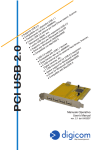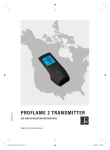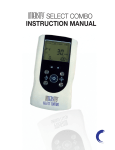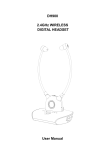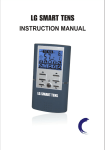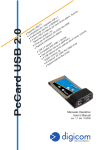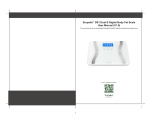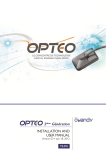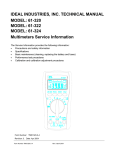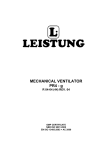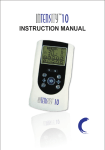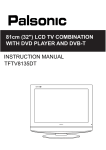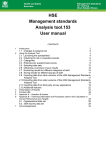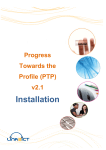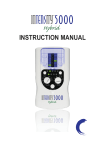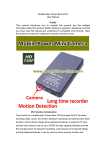Download TWIN STIM III INSTRUCTION MANUAL
Transcript
TWIN STIM III INSTRUCTION MANUAL ® TM This manual is valid for the InTENSity Twin Stim III TENS/EMS Combo Stimulator This user manual is published by Current Solutions™, LLC Current Solutions™, LLC does not guarantee its contents and reserves the right to improve and amend it at any time without prior notice. Amendments may however be published in new editions of this manual. All Rights Reserved.Rev.V1.1 © 2010 United States Federal Law restricts this device to sale by or on the order of a physician or licensed practitioner : Declaration of conformity: Current Solutions™, LLC declares that the device complies with following normative documents: IEC60601-1, IEC60601-1-2, I EC60601-2-10, IEC60601-1-4, ISO10993-5, ISO10993-10, ISO10993-1 Table of Contents 1. SAFETY INFORMATION………………………………………………………………….... 4 1.1 General description 1.2 Medical background 1.3 Indication for use 1.4 Contraindications 1.5 Warnings, Cautions, Adverse Reactions 2. PRESENTATION………………………………………………………………..………………... 12 2.1 Front and Rear panel 2.2 LCD display 3. SPECIFICATION……………………………………………………………..………………….... 15 3.1 Accessories 3.2 Technical information 3.3 The waveforms of the stimulation programs 4. INSTRUCTIONS FOR USE ………………………………..………………………......... 19 4.1 Battery 4.2 Connect electrodes to lead wires 4.3 Connect lead wires to device 4.4 Electrodes 4.5 Turn ON 4.6 Select the Therapeutic Mode 4.7 Steps to set a new program 4.8 Adjust Channel Intensity 4.9 Safty lock feature 4.10 Stop the treatment 4.11 Turn OFF 4.12 Low battery indicator 5. PROGRAM...........................................................................................................................… 28 6. CLEANING AND CARE…………………………………………………….……………….. 29 6.1 6.2 6.3 6.4 6.5 Tips for skin care Cleaning the device Electrodes Cleaning the Electrode cords Maintenance 7. TROUBLESHOOTING …………………………………………………………………….... 32 8. STORAGE……………………………………………………………………………………............. 33 9. DISPOSAL…………………………………………………………………………………................ 33 …… 33 10. ELECTROMAGNETIC COMPATIBITY (EMC) TABLES 11. GLOSSARY OF SYMBOLS 12. WARRANTY 35 46 3 1.Safety information 1.1 General InTENSity Twin Stim III is a portable electrotherapy device featuring TM two therapeutic modes: Transcutaneous Electrical Nerve Stimulator (TENS) and Electrical Muscle Stimulation (EMS), which are used for pain relief and electrical muscle stimulation. The stimulator sends gentle electrical current to underlying nerves and muscle group via electrodes applied on the skin. The parameters of device are controlled by the buttons on the front panel. The intensity level is adjustable according to the needs of patients. 1.2 Medical background EXPLANATION OF PAIN Pain is a warning system and the body’s method of telling us that something is wrong. Pain is important; without it abnormal conditions may go undetected, causing damage or injury to vital parts of our bodies. Even though pain is a necessary warning signal of trauma or malfunction in the body, nature may have gone too far in its design. Aside from its value in diagnosis, long-lasting persistent pain serves no useful purpose. Pain does not begin until the coded message travels to the brain where it is decoded, analyzed, and then reacted to. The pain message travels from the injured area along the small nerves leading to the spinal cord. Here the message is switched to different nerves that travel up the spinal cord to the brain. The pain message is then interpreted, referred back and the pain is felt. EXPLANATION OF TENS Transcutaneous Electrical Nerve Stimulation (TENS) is a noninvasive, drug free method of controlling pain. TENS uses tiny electrical impulses sent through the skin to nerves to modify your pain perception. TENS does not cure any physiological problem; it only helps control the pain. TENS does not work for everyone; 4 however, in most patients it is effective in reducing or eliminating the pain, allowing for a return to normal activity. HOW TENS WORKS There is nothing “magic” about Transcutaneous Electrical Nerve Stimulation (TENS). TENS is intended to be used to relieve pain. The TENS unit sends comfortable impulses through the skin that stimulate the nerve (or nerves) in the treatment area. In many cases, this stimulation will greatly reduce or eliminate the pain sensation the patient feels. Pain relief varies by individual patient, mode selected for therapy, and the type of pain. In many patients, the reduction or elimination of pain lasts longer than the actual period of stimulation (sometimes as much as three to four times longer). In others, pain is only modified while stimulation actually occurs. You may discuss this with your physician or therapist. EXPLANATION OF EMS Electrical Muscle Stimulation (EMS) is an internationally accepted and proven way of treating muscular injuries. It works by sending electronic pulses to the muscle needing treatment; this causes the muscle to exercise passively. It is a product derived from the square waveform, originally invented by John Faraday in 1831. Through the square wave pattern it is able to work directly on muscle motor neurons. This device has low frequency and this in conjunction with the square wave pattern allows direct work on muscle groupings. This is being widely used in hospitals and sports clinics for the treatment of muscular injuries and for the reeducation of paralyzed muscles, to prevent atrophy in affected muscles and improving muscle tone and blood circulation. HOW EMS WORKS The EMS units send comfortable impulses through the skin that stimulate the nerves in the treatment area. When the muscle receives this signal it contracts as if the brain has sent the signal itself. As the signal strength increases, the muscle flexes as in 5 physical exercise. Then when the pulse ceases, the muscle relaxes and the cycle is repeated. The goal of electrical muscle stimulation is to achieve contractions or vibrations in the muscles. Normal muscular activity is controlled by the central and peripheral nervous systems, which transmit electrical signals to the muscles. EMS works similarly but uses an external source (the stimulator)with electrodes attached to the skin for transmitting electrical impulses into the body. The impulses stimulate the nerves to send signals to a specifically targeted muscle, which reacts by contracting, just as it does with normal muscular activity. 1.3 Indication for use InTENSity TM Twin Stim III Stimulator may be used for For Transcutaneous Electrical Nerve Stimulator therapeutic modes (TENS): 1) Symptomatic relief of chronic intractable pain. 2) Post traumatic pain. 3) Post surgical pain. For Electrical Muscle Stimulation / Neuromuscular Stimulation therapeutic mode (EMS): 1) Relaxation of muscle spasm. 2) Increase of blood flow circulation. 3) Prevention of disuse atrophy. 4) Muscle re-education. 5) Maintaining or increasing range of motion. imulation of lower leg muscles to prevent venous thrombosis. IMPORTANT SAFETY INFORMATION! Read the instruction manual before operation. Be sure to comply with all “Contraindications”,“Warnings”, “Cautions” and “Adverse reactions” in the manual. Failure to follow instructions can cause harm to user or device. 1.4 Contraindications 1.5 Warnings, Cautions and Adverse Reactions 7 8 out of reach of children. you are in any doubt whatsoever. CAUTIONS: 13) Some patients may experience skin irritation or hypersensitivity due to the electrical stimulation or silicone rubber. If rash develops or pain persists, discontinue use and consult a doctor. 14) Electrode placement and stimulation settings should be based on the guidance of prescribing practitioner. 15) Effectiveness is highly dependent upon patient selection by a person qualified in the management of pain afflicted patients. 16) Isolated cases of skin irritation may occur at the site of the electrode placement following long-term application. If this occurs, discontinue use and consult your physician. 17) The electrodes are only to be placed on healthy skin. Avoid skin irritation by ensuring that good contact is achieved between electrodes and skin. 18) If the stimulation levels are uncomfortable or become uncomfortable, reduce the stimulation Intensity to a comfortable level and contact your physician if problems persist. 19) This device should not be used while driving, operating machinery, close to water, or during any activity in which involuntary muscle contractions may put the user at undue risk of injury. 20) Never use the device in rooms where aerosols (sprays) are used or pure oxygen is being administered. 21) Do not use it near any highly flammable substances, gases or explosives. 22) Do not use this device at the same time as other equipment which sends electrical pulses to your body. 23) Do not confuse the electrode cables and contacts with your headphones or other devices, and do not connect the electrodes to other devices. 24) Do not use sharp objects such as pencil point or ballpoint pen to operate the buttons on the control panel. 25) Inspect Applicator cables and associated connectors before each use. 26) Turn the device off before applying or removing electrodes. 27) Electrical stimulators should be used only with the leads and electrodes recommended for use by the manufacturer. 28) This device has no AP/APG protection. Do not use it in the presence of explosive atmosphere and flammable mixture. Adverse Reactions: 2. Presentation 2.1 Front and Rear Panel 12 intensity of channel 2 [▼]. Use to set rameter of the waveform in the current treatment program. ss the button to enter setting ▲] and [▼]. Press [ ] button and hold for cover for user access. 2.2 LCD display or Displays the cycle time for y for channel 1 (CH1); Display of S waveform of contraction raction (working) time 13 12) Display of the output intensity for channel 2 (CH2); Display of waveform pulse rate or EMS waveform of relaxation time in setting state. 13) Displays channel 2. 14) EMS waveform of relaxation time. 15) Displays the treatment time or EMS waveform of ramp up and ramp down time. 16) Low-battery indicator. 3. Specification 3.1 Accessories No 1 DESCRIPTION Electrical stimulator device Q’TY 1 piece 2 Electrode Leads 2 pieces 3 1.5”x 1.5” Adhesive Electrodes 4 pieces 4 9V Alkaline Battery, type 6LR61 1 piece 5 Instruction Manual 1 piece 6 Carrying case 1 piece 3.2 Technical information Channel Power l Operating conditions Dual, isolated between channels 9.0 V DC-1 Alkaline *6LR61 battery(optional AC Adaptor) Storage conditions -10°C to 50°C (14℉ to 122℉)with a relative humidity of 10%-90%,atmospheric pressure from 700 to 1060 Hpa 5°C to 40°C (41℉ to 104℉)with a relative humidity of 30%-75%,atmospheric pressure from 700 to 1060 Hpa Dimensions 4.5×2.55×0.9 inches(L*W*H) Weight 0.28 lbs(With battery) Tolerance There may be a ±5% tolerance of all setting and ±10% tolerance of output of intensity. Timer Electrode Detection Function Adjustable, from 1 to 60 minutes or continuous, Adjustable in 1minutes each step. Treatment time countdown automatically. The amplitude level will be reset to 0mA when the amplitude level is 12mA or greater and an open circuit at either channel is detected. Technical specifications for Transcutaneous Electrical Nerve Stimulator (TENS) mode Waveform Pulse amplitude Mono-phase square pulse wave Adjustable, 0~105mA peak at 1000 ohm Load each channel, 1mA/Step. Pulse Width Adjustable, from 50 to 300us microseconds, 10μS/step Pulse Rate Adjustable, from 1 to 150 Hz, 1 Hz/step Burst (B) Normal (N) Pulse Width Modulation (M) Pulse Rate Modulation (M1) Burst rate: Adjustable, 0.5 ~ 5Hz Pulse width adjustable,50-300uS Frequency fixed=10Hz The pulse rate and pulse width are adjustable. It generates continuous stimulation based on the setting value. The pulse width is automatically varied in a cycle time. The pulse width is decreased from its original setting to 60% in setting cycle time, and then increased from 60% to its original setting in nest setting cycle time. In this program, pulse rate (1 to 150Hz), pulse width (50 to 300us) and cycle time (5 to 30 sec) are fully adjustable. The pulse rate is automatically varied in a cycle time. The pulse rate is decreased from its original setting to 60% in setting cycle time, and then increased from 60% to its original setting in nest setting cycle time. In this program, pulse rate (1 to 150Hz), pulse width (50 to 300us) and cycle time (5 to 30 sec) are fully adjustable. Technical specifications for Electrical Muscle Stimulation (EMS) mode Waveform: Pulse amplitude Pulse Width Pulse Rate Contraction time Relaxation (OFF) time Ramp time Synchronous (S) Alternate (A) Delay (D) Mono-phase square pulse wave Adjustable, 0~105mA peak at 1000 ohm Load each channel, 1mA/Step. Adjustable, from 50 to 300μS microseconds, Adjustable, from 1 to 150 Hz, 1 Hz/step Adjustable, 1~60 seconds , 1 Sec./ step Adjustable, 0~60 seconds , 1 Sec./ step Adjustable, 1~6 seconds, 1 Sec. / step, The “On” time will increase and decrease in the setting value. Stimulation of both channels occurs synchronously. The “ON” time including “Contraction”, “Ramp Up” and “Ramp Down” time. ON TIME=Contraction + Ramp up + Ramp down The Stimulation of the CH2 will occur after the 1st operation of CH1 is completed. In this program, The “ON” time including “Contraction”, “Ramp Up” and “Ramp Down” time. The OFF Time should be equal or more than the ON Time ON TIME=Contraction + Ramp up + Ramp down OFF TIME ≥ ON TIME The Stimulation of the CH2 will occur after CH1 is started + Delay Time. In this program, The “ON” time includes “Contraction”, “Ramp Up” and “Ramp Down” time. ON TIME = Contraction + Ramp up + Ramp down time. The OFF Time should be equal or more than the ON Time + Delay Time. Time Delay time is adjustable from 1 to 10 seconds in this program. 3.3 The waveforms of the stimulation programs Burst (B) Normal (N) Pulse Width Modulation cycle time Pulse Rate Modulation Synchronous(S) Alternate (A) Delay (D) 4. Instruction for use 4 .1 Battery 4.1.1 Check/Replace the 9V ALKALINE battery Over time, in order to ensure the functional safety of device, the battery must be periodically changed. 19 4.1.2 Disposal of battery Spent batteries do not belong in household waste. Dispose of the battery according to the current federal, state and local regulations. Caution: 1) Battery may be fatal if swallowed. Therefore, keep the battery and the product out of the range of children, if a battery was swallowed, consult a physician immediately. 2) If a battery has leaked, avoid contact with skin, eyes and mucus membranes, Rinse the affected spots with lots of clear water immediately and contact a physician right away. 3) Battery may not be charged, dismantled, thrown into fire or short-circuited. 4) Protect battery from excess heat; Take the battery out of the product if they are spent or in case you no longer use the article. This prevents damage caused by leaking battery. 5) Always replace the same type battery. 4.2 Connect electrodes to lead wires Insert the lead wire connector into electrode connector (standard 0.08 inch female connection). Make sure there are no bare metal pins exposed. 20 Caution: Always use the electrodes with the requirements of the IEC/EN60601-1 ISO10993-1/-5/-10 and IEC/ EN60601-1-2, such as with CE mark, or which are legally marketed in the US under 510(K) procedure. 4.3 Connect lead wires to device 1) Before proceeding to this step, be sure the device is completely turned OFF. 2) The wires provided with the system insert into the jack sockets located on top of the device. 3) Holding the insulated portion of the connector, push the plug end of the wire into one of the jacks (see drawing); one or two sets of wires may be used. 4) This device has two output receptacles controlled by Channel 1 and Channel 2 at the top of the unit. You may choose to use one channel with one pair of lead wires or both channels with two pairs of lead wires. Using both channels gives the user the advantage of stimulating two different areas at the same time. Caution: Do not insert the plug of the patient lead wire into any AC power supply socket. 21 4.4 Electrode 4.4.1 Electrode options The electrodes are disposable and should be routinely replaced when they start to lose their adhesive nature. If you are unsure of your electrodes adhesive properties, order new replacement electrodes. Replacement electrodes should be re-ordered through or on the advice of your physician to ensure proper quality. Follow application procedures outlined in electrode packing, to maintain optimal stimulation and to prevent skin irritation. 4.4.2 Place electrodes on skin Apply electrodes to the exact site indicated by your physician or therapist. Be sure the skin surface over which electrodes are placed is thoroughly cleaned and dried. Make sure the electrodes are placed firmly to the skin and make good contact between the skin and the electrodes. Place the electrodes over the skin; attach them properly, firmly, and evenly. Caution: 1) Before applying the selfadhesive electrodes, it is recommended to wash and degrease the skin, and then dry it. 2) Do not turn on the device when the self-adhesive electrodes are not positioned on the body. 3) Never remove the self-adhesive electrodes from the skin while the device is still turned on. 4) It is recommended that, at minimum, 1.5” x 1.5” selfadhering electrodes are used at the treatment area 22 4.4.3 Electrode placement The placement of electrodes can be one of the most important parameters in achieving success with therapy. Of utmost importance is the willingness of the physician to try the various styles of electrode placement to find which method best fits the needs of the individual patient. Every patient responds to electrical stimulation differently and their needs may vary from the conventional settings suggested here. If the initial results are not positive, speak to your physician about alternative stimulation settings and/or electrode placements. Once an acceptable location has been achieved, mark down the electrode sites and the device settings, so the patient can easily continue treatment. 4.5 Turn on Before using the device for the first time, you are strongly advised to take careful note of the contraindications and safety measures detailed at the beginning of this manual (Safety information), as this powerful equipment is neither a toy nor a gadget! In order to turn on the device, PRESS and RELEASE the [ ] button.The operation page appears on the screen. 4.6 Select the Therapeutic Mode There are 2 therapeutic modes available –TENS and EMS. The therapeutic mode can be selected by pressing the [M] control. Caution: Consult your physician for your suitable therapeutic mode 4.7 Steps to Set a New Program 4.7.1 TENS Setting Press the [S] button cycle to enter the setting state. The settings can be adjusted according to the following steps: 1) Set the Therapeutic Program There are 4 programs in TENS therapeutic mode available –Burst (B), Normal (N), Pulse Width Modulation (M), and Pulse Rate Modulation (M1). The therapeutic program can be selected by pressing the [▲] and [▼] button. When you choose to “B” program, program [B] outside of the box will be flashing. 2) Set Cycle Time (Optional) Cycle time is adjustable from 5 to 30 seconds. Only modulation has this parameter setting. Press [S] button cycle to enter this menu, and then press the [▲] and [▼] button to adjusting the setting. 3) Set Timer Press [S] button cycle to enter this setting. The treatment time is adjustable from 1 to 60 minutes or Continuous. Press [▲] or [▼] button control to adjust setting. You can set the timer to “Continuous” mode by pressing the [▲] control when it shows 60 minutes. The output will be shut off when time is up. 4) Set Pulse Width Pulse Width is adjustable from 50 uS to 300 uS. Press [S] button to enter this menu, then press [▲] or [▼]button to adjust the setting. 24 5) Set Pulse Rate Pulse rate is adjustable from 1 Hz to 150 Hz (0, 5 Hz to 5 Hz for Burst). Press [S] button cycle to enter this menu, and then press [▲] or [▼]button to adjust the setting. 4.7.2 EMS Setting Press the [S] button cycle to enter the setting state. The settings can be adjusted according to the following steps: 1) Set the Therapeutic Program There are 3 programs in EMS therapeutic mode available –Synchronous, Alternate and Delay,. The therapeutic program can be selected by pressing the [▲] and [▼]button. When you choose to [S] program, program [S] outside of the box will be flashing. 2) Set Timer Press [S] button cycle to enter this setting. The treatment time is adjustable from 1 to 60 minutes or Continuous. Press [▲] or [▼] control to adjust setting. You can set the timer to “Continuous” mode by pressing the [▲] button when it shows 60 minutes. The output will be shut off when time is up. 3) Set Pulse Width The pulse width determines the length of time. Each electrical signal is applied through the skin, which controls the strength and sensation of the stimulation. Press [S] button cycle to enter this setting. The pulse width is adjustable from 50 to 300 uS. Press [▲] or [▼]button to adjust the setting. 4) Set Pulse Rate The pulse rate determines how many electrical impulses are applied through the skin each second. Press [S] button cycle to enter this menu. By pressing the [▲] or [▼]button to adjusting the setting. The pulse rate is adjustable from 1 Hz to 150 Hz. 5) Set Delay Time (Optional) Delay time is adjustable from 1 to 10 seconds. 25 Only Delay therapeutic program has this parameter setting. Press [S] button cycle to enter this menu, and then press the [▲] and [▼] button to adjusting the setting. 6) Set Ramp Time The ramp time controls the time of output current that increase from 0 to the 7) Set Contract Time The contract Time controls the time of stimulation. The contraction time can be adjusted. Press [S] button cycle to enter this menu, and then press the [▲] and [▼] button to adjusting the setting. Both channels’ stimulation is cycled on and off by the contraction and relaxation settings. The range is adjustable from 1 to 60 seconds. Caution: Contract time does not include the ramp up and ramp down time; ON time=Ramp up + Contract time + Ramp down. 8) Set Relaxation (OFF) time The Off Time controls the time of relaxation. The relaxation time can be adjusted. Press [S] button cycle to enter this menu, and then press the [▲] and [▼] button to adjusting the setting. Both channels' stimulation is cycled on and off by the contraction and relaxation settings. The range is adjustable from 0 to 60 seconds. In Alternate program, the OFF Time should be equal or more than the ON Time. (OFF TIME ≥ON TIME) 4.8 Adjust Channel Intensity Press the intensity control button ([▲] and [▼]) to control the intensity output. Slowly press the intensity button control until you reach the setting recommended by your physician or therapist. Repeat for the other channel, if both channels are to be used. Caution: 1) If the stimulation levels are uncomfortable or become uncomfortable, reduce the stimulation intensity to a comfortable level and contact your medical practitioner if problems persist. 2) If the electrodes are not placed firmly on the skin or the device is not connected to the electrodes, and the stimulator’s output intensity surpasses 12mA, the amplitude level will be reset to 0 mA automatically. 4.9. Safety Lock Feature The Safety Lock Feature automatically activates after there is no operation in the panel for 30 seconds by locking out the ability to press the buttons.This is a safety feature to prevent accidental changes to your settings and to prevent accidental increases to the intensity levels.You can press either one of the button to unlock the device. 4.10. Stop the treatment When you have activated the treatment timer, you can press the [M] button or the [ ] button to control or stop the treatment. Caution: Default state, if the button is locked, you can press only one of the [ ] buttons to unlock, and then press the [M] button or the [ ] button to control stop the treatment. 4.11. Turn OFF PRESS [ ] button and HOLD for approximately 3 seconds to turn OFF the device. Caution: 1) 2) If there is no operation in the panel for 2 minutes in the waiting state, the device will be turned off automatically. In shutdown state, keep pressing the channel 2[ ]first, and then press [ ]button at the same to restore factory parameter settings 27 4.12. Low battery indicator When the low power indicator flashes, the device will be turned off automatically, the battery should be replaced with a new one as soon as possible. However, the unit may continue to operate for an extended period depending on the setting intensity level. 5. Program Mode TENS EMS Program Modulation Method Frequency Pulse Width Treatment time B Burst 0.5-5Hz 50-300us 1-60min,continuous N Continuous 1-150Hz 50-300us 1-60min,continuous M Pulse width modulation 1-150Hz 50-300us 1-60min,continuous M1 Frequency modulation 1-150Hz 50-300us 1-60min,continuous S Synchronous mode 1-150Hz 50-300us 1-60min,continuous A Asynchronous mode 1-150Hz 50-300us 1-60min,continuous D Delay mode 1-150Hz 50-300us 1-60min,continuous 28 6. Cleaning and Care 6.1 Tips for skin care To avoid skin irritation, especially if you have sensitive skin, follow these suggestions: ou will be placing the electrodes, using mild soap and water before applying electrodes, and after taking them off. Be sure to rinse soap off thoroughly and dry skin well. 2) Excess hair may be clipped with scissors; do not shave stimulation area. 3) Wipe the area with the skin preparation your clinician has recommended. Let this dry. Apply electrodes as directed. 4) Many skin problems arise from the “pulling stress” from adhesive patches that are excessively stretched across the skin during application. To prevent this, apply electrodes from center outward; avoid stretching over the skin. 5) To minimize “pulling stress”, tape extra lengths of lead wires to the skin in a loop to prevent tugging on electrodes. 6) When removing electrodes, always remove by pulling in the direction of hair growth. 6.2 Cleaning the device 1) Remove the battery from the device every time when you clean. 2) Clean the device after use with a soft, slight moistened cloth. In case of more extreme soiling you can also moisten the cloth with mild soapy water. 3) Do not use any chemical cleaners or abrasive agents for cleaning. 6.3 Electrodes 1) Use the device only with the leads and electrodes provided by the manufacturer. Use only the electrode placements and stimulation settings prescribed by your physician or therapist. 2) It is recommended that, at minimum, 1.5” x 1.5” self-adhering electrodes should be used at the treatment area. 3) Inspect your electrodes before every use. Replace electrodes as needed. Reusable electrodes may cause slight skin irritation, lose adhesion and deliver less stimulation if overused. To use these electrodes: To remove your electrodes: Caution: 1) Do not pull on the electrode wire. Doing so may damage the wire and electrode. 2) Do not apply to broken skin. 3) The electrodes should be discarded when they are no longer adhering. 4) The electrodes are intended for single patient use only. 5) If irritation occurs, discontinue use and consult your clinician. 6) Read the instructions for use of self-adhesive electrodes before application. 7) Always use the electrodes with the requirements of the IEC/EN60601-1, ISO10993-1/-5/-10 and IEC/ EN60601-1-2, such as with CE mark, or are legally marketed in the US under 510(K) procedure. 6.4 Cleaning the Electrode's cords Clean the electrode cords by wiping them with a damp cloth. Coating them lightly with talcum powder will reduce tangles and prolong the life. 6.5 Maintenance 31 7. Troubleshooting If your device does not seem to be operating correctly, refer to the chart below to determine what may be wrong. Should none of these measures correct the problem, the device should be serviced. Problem Display fails to light up Possible Cause Battery contact failure Solution 1. Try fresh batteries. 2. Ensure batteries are inserted correctly. Check the following: • All contacts are in place Stimulation weak Electrodes or Lead Wires 1. Dried out or contaminated 2.Placement of lead wires 3.Old/worn/damaged electrodes or lead wires Stimulation is uncomfortable Intermittent output Replace and re-connect Replace 1.Decrease intensity. 2.Reposition the electrodes. 3.Replace. 4.Replace electrodes with ones that have an active area no less than 1.5” X 1.5” 1. Verify connection is secure and firmly seated. Lead wires 2. Turn down the intensity. Rotate lead wires in socket 90°. If still intermittent, replace lead wire. 3. If still intermittent after replacing lead wire, a component may have failed. Call the repair department. Program option in use Some programs will seem intermittent. This is expected. Refer to the Program Option Stimulation is ineffective. Improper electrode and Reposition electrode and applicator applicator placement Contact clinician. Unknown 32 8. Storage 1) For a prolonged pause in treatment, store the device in a dry room and protect it against heat, sunshine and moisture and remove the battery. 2) Store the device in a cool, well-ventilated place 3) Never place any heavy objects on the device. 9. Disposal Used fully discharged batteries must be disposed of in a specially labeled collection container, at toxic waste collection points or through an electrical retailer. Please dispose of the device in accordance with the legal obligation. 10. Electromagnetic Compatibility (EMC) Tables Guidance and manufacturer’s declaration - electromagnetic emissions The device is intended for use in the electromagnetic environment specified below. The customer or the user assures that it is used in such an environment. Emissions test Compliance RF emissions Group 1 CISPR 11 RF emissions CISPR11 Class B Harmonic emissions lEC 61000-3-2 Not applicable Voltage fluctuations / flicker emissions lEC 61000-3-3 Not applicable Electromagnetic environment – guidance The device uses RF energy only for its internal function. Therefore, its RF emissions are very low and are not likely to cause any interference in nearby electronic equipment. The device is suitable for use in all establishments other than domestic and those directly connected to the public low-voltage power supply network that supplies buildings used for domestic purposes. Guidance and manufacturer’s declaration — electromagnetic immunity The device is intended for use in the electromagnetic environment specified below. The customer or the user should assure that it is used in such an environment. Immunity test IEC 60601 test level Electrostatic discharge (ESD) lEC 61000-4-2 ±6 kV contact ±8 kV air Compliance Level ±6 kV contact ±8 kV air 33 Electromagnetic environment -Guidance Floors should be wood, concrete or ceramic tile. If floors are covered with synthetic material, the relative humidity should be at least 30 %. Guida ance and- manufacturer m r’s declaratio on. Electrom magnetic imm munity The devvice is intended for use in. the electtromagnetic environmen nt specified below. The customer or theusser should assure a that it is used in such s an env vironment. Immunity test IEC 60501 test level p Elec ctromagneticc environment - guidanc ce Compliance level m RF co ommunicatio ons Porrtable and mobile uipment sho ould be used d no closer to o any equ parrt of the deviice, including cables, than the recommended separation distance calculated from m the equation applicab ble to the fre equency of the transmittter. Rec commended d separation n distance Conduccted RF lEC 610 000-4-6 3 Vrms 150 kHz t o 80 MHz Radiated d RF lEC 3 V/m80 MHz to 2 5 GHz 61000-4 4-3 . 3 Vrms , 80M MHz to 800M MHz 3 V/ m , 800 0MHz to 2,5M MHz e maximum o output powe er rating W ere P is the of the transmitter In watts ((W) accordin ng to the. Transmitter manufactu urer and d Is s the recommended separation distance in meters (m) Field strengths from fixed R RF transmittters, as determined d by an electrromagnetic site s surrvey, should be less than the com mpliance levvel in each freq quency rang ge. Inte erference may occur In the vicinity of o equ uipment marrked with the e following sym mbol: NOTE I At 80 MHz ends 800 MHz. M the higher frequency range ap pplies. delines mayy not apply in n all situatio ons. Electrom magnetic pro opagation is s NOTE 2 These guid affected d by absorpttion and reflection from structures, objects o and people. 1. Field strengths frrom fixed tra ansmitters, such s as base e stations fo or radio (cellular/cordless) teleph hones and la and mobile radios, r amatteur radio, AM A and FM radio r broadccast and TV broad dcast cannott be predicte ed theoretica ally with acc curacy. To assess the electromagne etic enviro onment due to fixed RF transmitterss, an electro omagnetic siite survey sh hould be con nsidered. If the measured field f strength h in the loca ation in which h the device e is used excceeds the ap pplicable RF co ompliance le evel above, should be observed to verify v norma al operation. If abnorma al performan nce is observ ved, addition nal measure es may be necesssary, such as reorientin ng or relocating the dev vice. 2. Over the t frequenccy range 150 0 kHz to 80 MHz, field strengths s sh hould be lesss than [Vi] V/m. V 34 Reco ommended separation s distances d be etween portable and mo obile RF com mmunication ns equipmen nt and the de evice The devvice is intended for use in an electro omagnetic environment e t in which radiated RF disturba ances are co ontrolled. Th he customerr or the userr of the devic ce can help prevent electrom magnetic intterference byy maintainin ng a minimum distance between portable and mobile m RF com mmunications equipment (transmitte ers) and the as recomme ended below w, according g to the maximu um output po ower of the communicat c tions equipm ment. Ra ated maximu um o output powe er of transmitter W Se eparation dis stance acco ording to freq quency of transmittter Hz M 150 kHz to 8 80 MHz 80 MHz to 800 0 MH 800 MHz to 2,5 GHz 0,01 0.12 0.12 0.23 0,1 1 0.38 1.2 0.38 1.2 0.73 2.3 10 3.8 3.8 7.3 100 12 12 23 For tran nsmitters ratted at a max ximum outpu ut power nott listed abovve, the recom mmended separattion distance e d in meters s (m) can be e estimated using the eq quation app plicable to the frequen ncy of the tra ansmitter, where P is the e maximum output pow wer rating of tthe transmittter in watts (W W) accordab ble to the tra ansmitter ma anufacturer. NOTE I At 80 MHz and 800 MH Hz. the sepa aration dista ance for the higher frequ uency range applies. NOTE 2 Th hese guideliines may no ot apply in alll situations. Electromag gnetic propaga ation is affeccted by absorpttion and refle ection from structures, o objects and people. 11. Glossary of Symbols Batch code… ……..01000001 Serial numbe er……50000001 Attention: Re ead the operatting instruction n for use! Meaning of the symbols on n the product, the packaging or in the ope erating instructions: electric device es are recycla able material and a should nott be disposed of with household w waste after theiir useful life! Help H us to prottect the enviro onment and sa ave resources an nd take this de evice to the ap ppropriate colle ection points. Please contac ct the organization which is responsible for wa aste disposal in your area if you have any y questions. Degree of Electrical Protecction BF 35 12. Warranty Please contact your dealer in case of a claim under the warranty. If you have to send the unit back to your provider, enclose a copy of your receipt and state what the defect is. The following warranty terms apply: 1) The warranty period for device is one year from date of purchase. In case of a warranty claim, the date of purchase has to be proven by means of the sales receipt or invoice. 2) Repairs under warranty do not extend the warranty period either for the device or for the replacement parts. 3) The following is excluded under the warranty: All damage which has arisen due to improper treatment, e.g. nonobservance of the user instruction. All damage which is due to repairs or tampering by the customer or unauthorized third parities. Damage which has arisen during transport from the manufacturer to the consumer or during transport to the service centre. Accessories which are subject to normal wear and tear. 4) Liability for direct or indirect consequential losses caused by the unit is excluded even if the damage to the unit is accepted as a warranty claim. 36 Manufactured for: Current Solutions LLC 3814 Woodbury Drive Austin,TX 78704 Ph:(800)871-7858 www.currentsolutionsnow.com TM








































